What if the teenage years weren’t something to survive but a vital chapter to understand, support, and even celebrate?
Adolescence has always been a time of self-discovery and identity formation, when young people begin to establish a sense of who they are, what they believe in, and where they fit in the world. Adolescence is a deeply sensitive developmental window, characterized by significant opportunities, as well as vulnerabilities.
And so it matters greatly if a teenager is afforded opportunities to establish a strong foundation for personal and social growth. According to a study from Monash University in Australia,
Teenagers who have a strong sense of identity are more empowered to make positive life decisions. This makes them likely to make healthy choices and have a positive outlook on life. They are also better-equipped to handle challenges, such as peer pressure and academic stress.
This makes it essential for young people to develop a powerful identity in order to successfully navigate the changes taking place, and have a strong sense of self-worth, self-esteem, and self-awareness. This sets them up for future success, empowering them to become confident adults. A clear identity makes people more resilient, reflective, and autonomous in the pursuit of important life decisions, while promoting a sense of competence.
This recognition was at the heart of the Junior High’s interdisciplinary humanities class, “The History of the American Teenager,” during which a group of Marin Montessori teenagers turned their attention inward and examined their own experience and sense of self through the lens of history.
With the goal of better understanding themselves and their experiences today, they explored how the very concept of “the teenager” came to be, tracing its emergence through the cultural shifts of the past century: the rise of compulsory education and high school culture, the dawn of the automobile, rock and roll, and youth-driven social movements.
They compared and contrasted their lives today to those of American teenagers living during the past century. The study of those who came before provided both context and opportunities for personal connection. Through this comparison of teenage culture, differences were noted in teenage clothing styles, pastimes, and gender norms.
They also began to recognize some common threads, including misunderstanding by adults, negative adolescent stereotypes, a tendency towards rebellion, and the importance of music and dance in their formation of self-identity.
The gallery below features student work comparing teenage culture from a past decade to their own lives today.
The profoundly personal subject matter made learning not only relevant but deeply engaging. This was especially apparent in the weekly Socratic Seminars. A Socratic seminar is a structured class discussion, during which students lead the questioning and discussion, rather than the teacher. The goal is to encourage critical thinking, deeper understanding, and the ability to engage in thoughtful, collaborative conversations.
As students reflected on questions such as, “What does it mean to be a teenager today?” and “What is most exciting and most challenging about coming of age during this period in history?” they became increasingly comfortable sharing authentically about their lives and experiences. The few more vocal students paved the way with their vulnerability, sharing about their personal struggles and their triumphs, making it safe for others to follow suit.
While adolescence can feel like such a solitary, inward period of life, the seminars provided opportunities for them to hear and be heard, to see and be seen, and to hold space for one another. At the end of the first seminar, one student remarked, “Wow, that was like group therapy.”
Another student, Poppy, shared,
A lot of the time, it’s hard to get to know yourself, and you feel alone sometimes. This class allowed us to get to know ourselves and my fellow classmates. I was excited to go to class because I got to share my experiences. It was refreshing to hear about others’ experiences. And you realize that we have many of the same wants, needs, and motivations as our peers, as well as teenagers who came before us. We’re writing the history of today’s teenage experience through our firsthand experiences and sharing with one another.
As students became increasingly more comfortable sharing about their lives and inner worlds, they also deepened their capacity to listen and hold space for others. This development increases empathy and will serve them greatly in life as they navigate relationships.
Another highlight of the class was the parent interview. It’s one thing to read about history and another thing to hear it firsthand from those you know and love. Students were tasked with interviewing their parents about their own experiences as a teenager, asking questions such as:
- What were you like as a teenager?
- What was your relationship like with your parents during your teenage years?
- What are some similarities you see between your experience as a teenager and mine?
- What are some differences?
- What advice do you have for teenagers today?
Students reflected on their interview experience together in a Socratic Seminar. It was apparent that the interview fostered connection and provided an opportunity for new understandings and greater empathy between parent-adolescents, as well as amongst their classmates.
One eighth-grade student shared, “When I picture my mom, I picture her as the adult she is today. Looking back at photos was a strange, but comforting experience to see my mom at the age that I am now. I got to know my mom better, in a different way that I hadn’t really known before. It was interesting to hear why my mom is the way that she is today. I realized that my mom is trying to make up for some of the things that she didn’t have as a teenager; I get a lot more supervision and support than she had.”
The class studied adolescent psychology and brain development, unlocking the mysteries of both their unique strengths — increased creativity, empathy, and a proclivity for social justice — and some of the daily challenges many of them contend with — heightened emotions, struggles with executive functioning.
They analyzed teenage characters in films. wrote personal “Philosophies of Life,” and authored their own “Teenager Bill of Rights” inspired by the one published in the New York Times in 1945.
And finally, they examined Maria Montessori’s vision for the adolescent: a purposeful, hands-on environment that treats teenagers not as problems to solve, but as humans in the midst of becoming. They considered how Marin Montessori Junior High was designed to meet their developmental needs, foster independence, and allow them to try out different roles and contribute in meaningful ways.
For their capstone project, students were asked to create an art piece that reflects their experiences as teenagers today and/or captures the essence of adolescence. These projects took on a variety of creative forms, including videos, origami sculptures, and even a time capsule representing teenage life.
For my creative project, I decided to try and capture my life as a teenager in a four-minute video. It ended up turning into more of a tribute to my friends. As someone who’s always been a bit of an outcast, finding my people at MMS has been amazing. Given how scary the world is right now, I think that the most important thing is being together, no matter the challenges we have to face.
Rio, 8th Grader
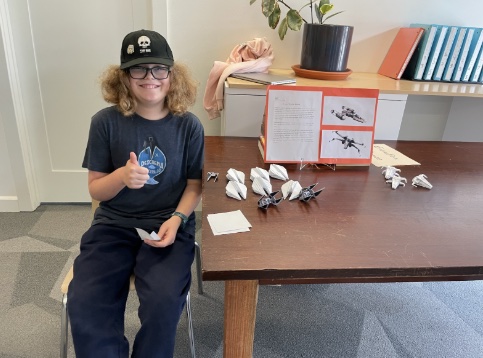
As many people probably know, I like to do origami. And I do it in school during class, even when I am not supposed to, so, in that way, it’s a form of rebellion. My reasons for this are that I want something to do with my hands, and it helps me focus more. I make origami X-wing and Y-wing starfighters from Star Wars. They are part of the Rebel Alliance against tie strikers and interceptors, which are part of the evil Galactic Empire. The Star Wars plot speaks to teenage rebellion and can resemble the dynamic of teens vs. parents. For this project, I used my passion for origami to capture the spirit of teenage rebellion. I decided to write this paragraph, print a bunch of copies, and fold them into origami.
David, 7th Grader
This project is a timely, thoughtful, and deeply personal window into the lives of adolescents today—and a testament to what becomes possible when students are invited to understand and honor who they are becoming right now.

Ali has been a member of the Marin Montessori Junior High faculty since 2013. A graduate of the University of California, Santa Cruz, she holds a bachelor’s degree in environmental studies and a master’s degree in education. She also holds both an elementary and an adolescent diploma from the Association Montessori Internationale (AMI).
Ali brings to the Junior High her love of place-based education, honed during five years as a naturalist. Curriculum development and classroom teaching fuel her creativity and inspire her daily. She finds deep fulfillment in crafting engaging, meaningful learning experiences.


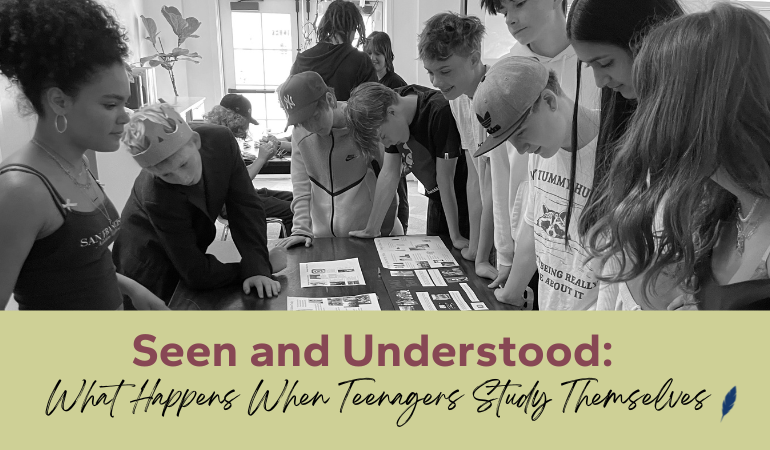
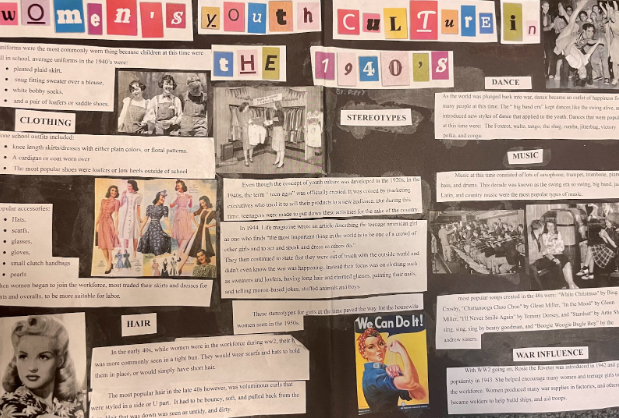
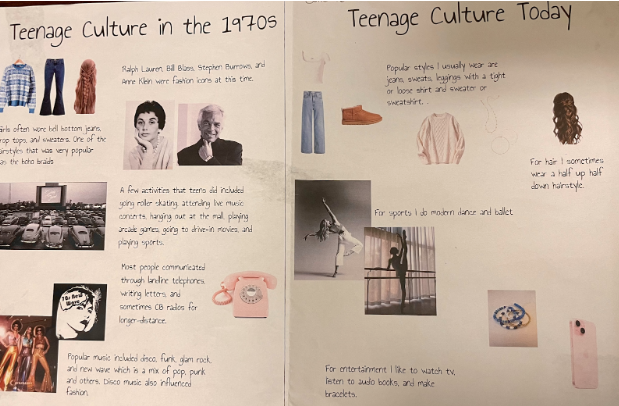
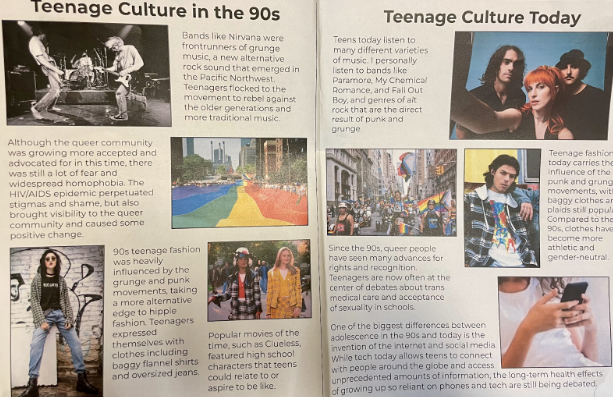
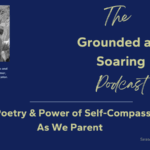
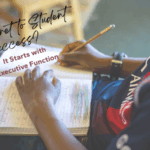

Jeannette Schar
What a fantastic project and class! I love the intense inward and outward look, the critical thinking and comparisons among teenagers today and decades past, and I especially appreciate the parent interview component. The latter really is a reflection too of our teenagers developing empathy for their adults while also seeing the importance of their adults’ teen years in how they live and love today as adults. I love knowing these students had a chance to also learn that grappling with their identity is normal and it is how they choose to unpack those feelings that is most important.
Sam Shapiro
Agreed, Jeannette! I especially loved that there was the parent interview component. What a powerful opportunity for connection, and for the teenagers to understand that they’re experiencing something (i.e. adolescence) that–while certainly unique for their specific time and place–is universal.